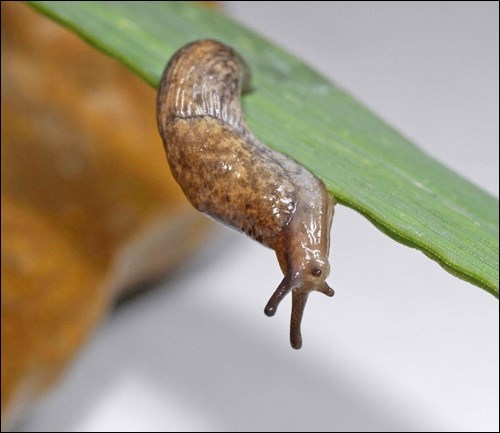I have a brick mowing edge between my lawn and my wood-mulched shrub/perennial beds. Recently, I’ve wondered why the birds insist on digging through the mulch and scattering it over the brick and into the lawn. This weekend, I discovered why as I was pruning back my Wilton juniper: they’re on the hunt for the multitude of juicy slugs that have invaded my garden.
Slugs are gastropods, not insects, related to snails and clams rather than to flies and beetles. They are nocturnal creatures and the most telling clue that you have slugs in your garden aside from the damage is the silvery trails they leave behind. And their preferred habitat is damp which unfortunately describes a lot of territory.
Growing up on the West Coast where slugs come in many shapes, sizes and colours, I particularly remember the banana slug named for its resemblance to said fruit in colour AND size. Thankfully in most Saskatchewan gardens, you’ll typically only encounter the diminutive grey garden slug (Deroceras reticulatum): small, 1 - 2 cm long, dark to light grey, shiny and, of course, slimy. Don’t let their size fool you. What they lack for in size, they can rapidly make up in number, laying 200-300 eggs at a time. And in numbers they are voracious, decimating leafy plants and most other garden plants including root crops like potatoes and carrots (unfortunately not dandelions in my experience). Slugs and their tiny eggs can move in from the neighbour’s yard, on plants from the nursery or your friends, on borrowed tools and even on the bottom of your shoes.
There are ways to fight back. Start by making your garden less hospitable by removing daytime hiding places like wooden boards, bricks, stones, and garden gnomes. Remove all decaying vegetation throughout the season, the fall especially.
Trapping slugs is a good next option. They are attracted to yeasty, fermenting odors. But don’t waste your beer: add a package of bread yeast to a cup of water sweetened with sugar, stir and set aside to bubble away for a couple of hours. Add an inch of the yeast solution to any shallow container (e.g. empty cat-food or tuna tins). Place several in the garden in the early evening, about 10 feet apart. Next morning, empty the containers (hopefully filled with drowned slugs) and repeat. Another option is to place short boards in the garden. In the morning, just scrape any cowering slugs off the bottom-sides into a bucket of soapy water. Repeat. Another effective trap is an upside down rind of a half grapefruit. Slugs can’t help themselves and will be found munching away in the morning on the inside. Simply dispose of rind, slugs and all. Repeat.
There are a number of control options, most of which are safe to use around your home, children and pets. Slugs are said to avoid wood ash and coffee grounds (some coffee shops give bags of grounds away for free). If nothing else, these will enrich your soil. To a slug, crushed baked eggs shells sprinkled around the garden act like razor wire, as does diatomaceous earth (DE), a powdery substance composed of sharp fossilized microscopic hard-shelled algae or diatoms. There are several registered insect and slug control DE products (e.g. Safer’s Insectigone). Do not use pool-grade DE. Wear a face mask to avoid breathing in the fine particles when sprinkling around the garden. Reapply after heavy rains.
After a meal of iron phosphate (registered slug control product; is safe around children and pets when applied according to label instructions), slugs stop eating and die. As a last resort, there are several registered metaldehyde slug control products. While very effective, metaldehyde is poisonous to slugs, people and their pets alike and should be used with care.
This column is provided courtesy of the Saskatchewan Perennial Society (www.saskperennial.ca; [email protected]; www.facebook.com/saskperennial). Check out our Bulletin Board or Calendar for upcoming garden information sessions, workshops, tours and other events.
GardenLine (http://gardenline.usask.ca) is here until Sept. 1 to help solve your gardening glitches. FREE. Phone (306) 966-5865 or email [email protected].
A grey garden slug defying gravity by hanging upside down. Photo by Joseph Berger




